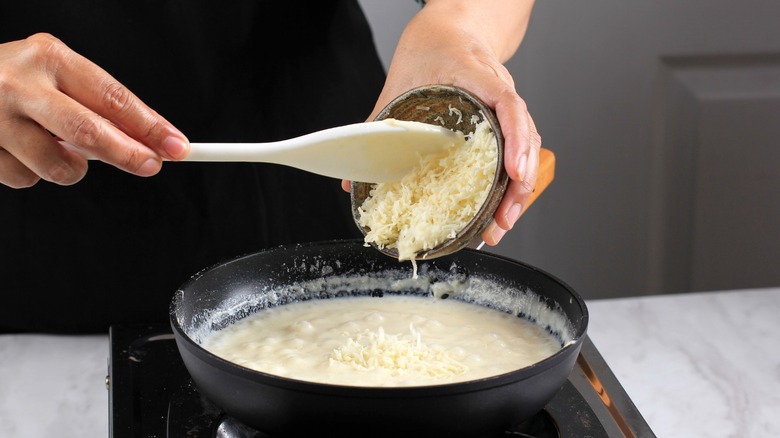The Only Type Of Pan You Should Use To Melt Cheese
Melting cheese isn't exactly rocket science. The dairy product will just start breaking down on its own as soon as you place it on the stove, forming a finger-licking creamy sauce, right? Well, yes and no. While scientifically, most cheeses naturally transform from a solid to a liquid-like state under high temperatures, on the other hand, the culinary skills and expertise needed to produce a perfectly smooth and delicious melted pot of cheesy goodness may not be as obvious as some may think.
Apart from choosing the right kind of cheese to melt, you'll also need the proper tools of the trade, like using the correct type of pan. Whether you're whipping up melted cheddar to dress your vegetable salad or preparing a pot full of cheesy goodness for a fondue party, the only type of pan you should reach for is the non-stick kind. This coated pan will ensure your mozzarella doesn't readily stick to the bottom of the vessel and start burning even before all your cheese has melted.
For perfectly melted cheese use a non-stick pan and follow these tips
A non-stick pan will not only spare your dairy products from easily burning from the bottom but also ensure the few stray bits of cheese that stick to the sides of the pan don't stay there and eventually get burnt. This will spare your sauce from ending up with traces of charred parmesan, which can make your finished dish less smooth than you would like. Additionally, a non-stick pan or skillet makes for an easier washing time after the cooking phase.
In addition to using an anti-adhesive pan, you'll need to pay close attention to the melting cheese and stir it frequently. The moment you leave it on the stove for several minutes, just laying still without mixing, it will start sticking to the pan's surface and eventually burn even if your pan is non-stick. Moreover, stirring helps distribute the heat within the cheese, allowing it to melt out more evenly to produce a smoother final texture.
Lastly, keep the cooking temperature at a minimum. If you're in a hurry and think more heat will quicken the process, it won't. You'll likely just end up with burnt gouda stuck to the bottom of the pan. So lower the dial on your stove, exercise patience, and you'll be rewarded with a perfectly melted cheese sauce.

